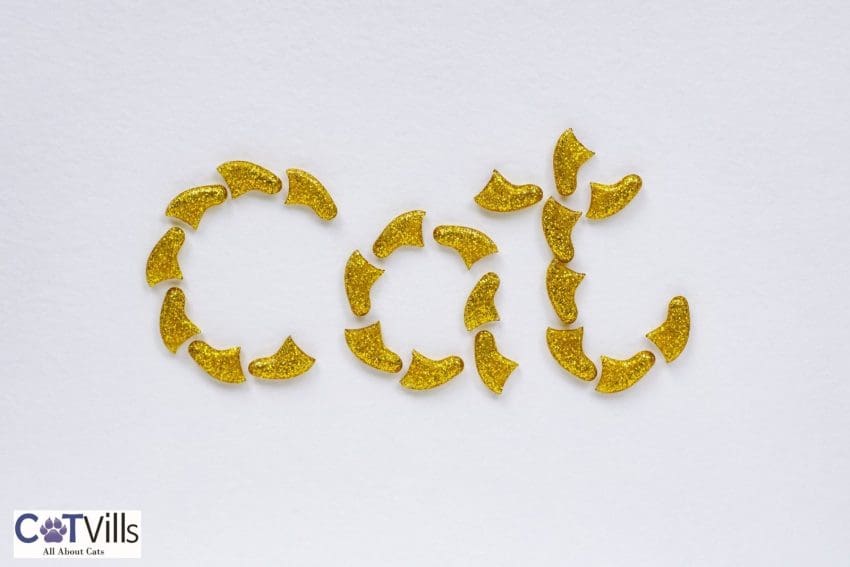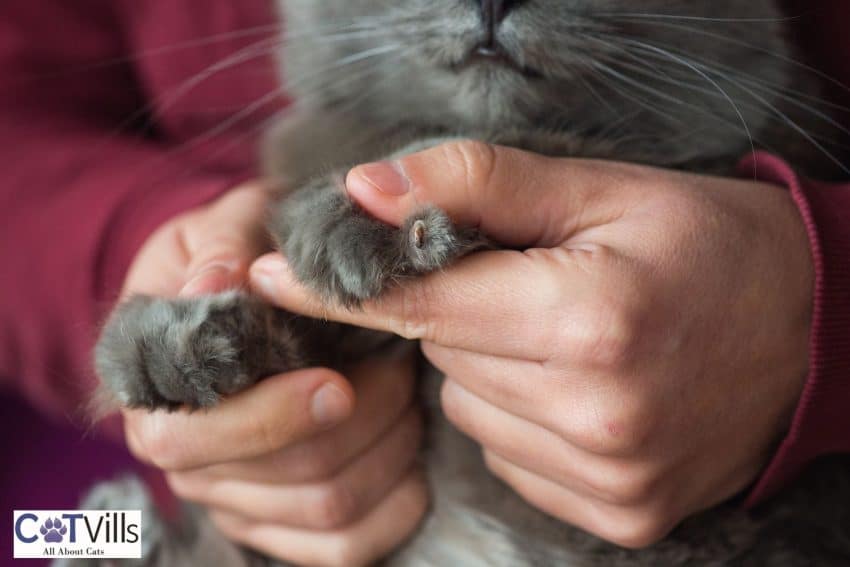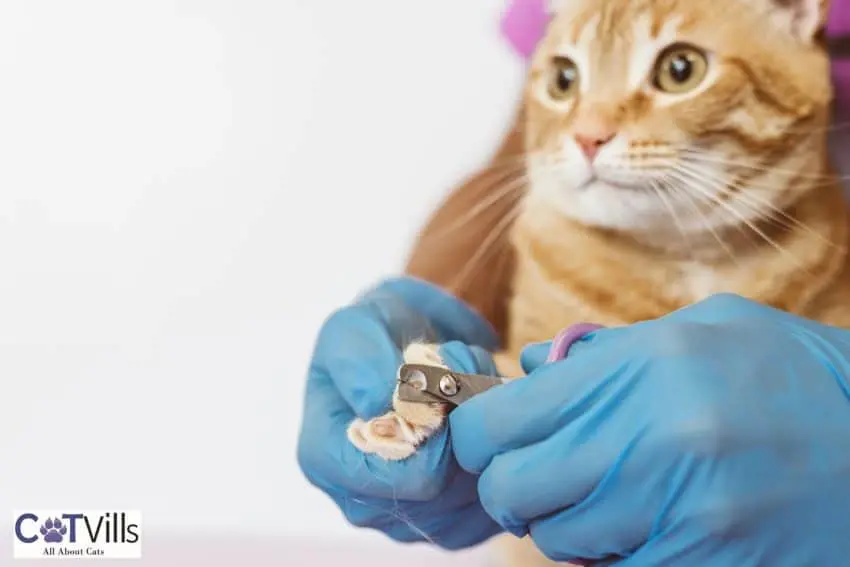Last Updated: 4 months ago
Cat nail caps are one of the more exciting products available for cat owners.
After all, these caps help curb unwanted scratching behaviors. But the question everyone wants to know is whether they’re safe.
We’ll provide an answer and a lot more in this guide.
Definition of Nail Caps

Cat nail caps are helpful to prevent issues like sharp scratching or furniture destruction. These caps usually have flexible plastic that fits over your cat’s claws.
But flexible plastic isn’t the only material used when creating these products. Manufacturers also use rubber, PVC, and vinyl resin to create them.
So it becomes a matter of selecting what material best suits your cat. For instance, my cat likes caps made from flexible plastic rather than rubber.
I must note that all material used in creating a nail cap needs to be non-toxic. It’s a safety precaution to ensure your cat doesn’t have side effects or an allergic reaction.
Are nail caps safe for cats?
A common myth surrounding cat nail caps is that they prevent cats from retracting their claws. But it’s not true when these caps are correctly applied.
In fact, correctly applied nail caps won’t cause any damage or pain to a cat’s nail bed. Cats’ nails will even continue to grow naturally without issue. They are an excellent humane alternative to declawing.
Your cat will then have no problems stretching and retracting its claws. As a result, cat nail caps are more than safe for indoor cats.
Outdoor cats are different because these nail caps aren’t for them. After all, these products get rid of a cat’s primary defense mechanism.
So it becomes problematic for a cat who adventures outside and encounters animals. They would have no way of defending themselves against a coyote or an unfamiliar dog.
Overall, you must monitor your cat’s behavior changes when adjusting to the kitty caps. For example, they could be extremely bothered by them or interfere with your cat’s routine.
Remember, cat nail caps aren’t for everyone. But if your cat doesn’t seem too bothered by them, they can function as a valuable tool.
Why would people use cat claw caps? (6 Reasons)

If you do have an indoor cat, there are several reasons why using kitty caps makes sense. I’ll discuss a few of them to help decide whether it’s suited for your cat.
1. Protects Your Drapes and Furniture
Nail caps represent one of the more effective ways of preventing cats from clawing fabric. If your cat has a habit of tearing apart drapes or furniture, these products could stop them.
It’s worth noting that it won’t stop them from attempting to claw at the materials. So if a nail cap comes off accidentally, your cat’s first move will be to scratch everything in sight.
2 Helps Prevent Accident Injuries or Scratches
One of the more obvious uses for cat nail caps is preventing cats from scratching people. Many cat owners have found them very helpful in dealing with this aggressive behavior.
I’d also suggest them for cats who aren’t used to being around strangers or small kids. A nail cap’s soft tip will protect humans against your cat feeling uncomfortable in these situations.
3. Fairly Inexpensive
In most cases, nail caps are inexpensive to buy for cat owners. It becomes even cheaper when you can learn how to apply them yourself.
I’ll have more on applying cat nail caps later.
But the main point is that these nail caps are much cheaper than professional nail trimming. You’ll end up saving yourself a ton of money.
4. Training Aid For Scratching Posts
Some cats take a little while to use scratching posts. Nail caps can help, as they don’t cause permanent changes to your cat’s claws or paws.
As a result, these nail caps are a smart little training aid for picky cats. It lets them have a more comfortable experience when first testing out a scratching post.
5. Versatile Enough to Work for Short-term and Long-term Situations
Nail caps offer significant versatility for cat owners as well. They can use them as short-term or long-term solutions for preventing scratching issues.
In any case, I recommend only using them as long as your cat needs them. Anyone who notices their cat not trying to scratch the furniture should take off these caps.
You can then see if they return to their old scratching habits. You can always put them back on a mischievous cat if they do.
6. No Increased Risk Of Infection
Cat nail caps won’t cause any risk for infections in your cat’s paw. It’s another reason these products are a much better idea than declawing a cat.
But poorly applied caps can raise infection risk. Cat owners must ensure they’re using the caps correctly and not causing abrasions or irritation.
Are there any downsides to using nail caps?

Of course, these caps for cats aren’t solutions to bad scratching behavior. Several issues can come from using these caps:
1. Need Replacing Regularly
These products aren’t a fixture of a cat’s claws. Instead, these caps are a temporary fix rather than a permanent solution.
You can even expect the caps to fall off as your cat’s claws experience natural growth. Most pet owners find caps to last “between four and six weeks before they have to be replaced.”
As you can imagine, frequent caps changing can be a nightmare as some cats will fight it.
2. Some Cats Won’t Tolerate Them
Cats aren’t too fond of people touching their paws. In some cases, felines will flat out refuse to let anyone near their nails, even a professional groomer.
Anyone who dares to try will receive scratches or bites. These outcomes aren’t anything a cat owner wants to experience.
3. Can Affect How Your Cat Walks
Cat nail caps can affect your cat’s natural movements initially. These caps can make them move differently and abnormally from what owners are used to seeing.
But this issue will usually resolve itself with extended usage. However, some cats never acclimatize to the caps and continue walking weirdly.
4. Outdoor Cats Can’t Use Them
As I mentioned earlier, outdoor felines can’t use caps for cats. They leave cats defenseless against other animals roaming outside your home.
I’d recommend only letting a cat outside with nail caps when you’re taking them on a leash. You can then act as their defense mechanism if something does happen.
5. Some Cats Chew and Swallow Them
There have been cases of cats chewing nail caps to remove them. If they succeed, the cat could swallow these caps and require a trip to the vet.
Don’t hesitate to take them to the vet, either. A swallowed nail cap can cause an obstruction if left unchecked.
6. Hampers Your Cat’s Climbing Ability
Cats who love climbing, running, and jumping can find it challenging to continue with nail caps. After all, cats use their claws to grip when climbing, and the caps will limit their functionality.
It’s also a concern for cats trying to keep their balance on unstable surfaces. Cat nail caps do not offer the same traction as a cat’s claws.
Best Nail Cap Brands
Finding the best brands for cat nail caps is a crucial part of using them. After all, you want high-quality products protecting your cat’s nails.
So I’d recommend sticking with brands like Soft Paws or Zetpo. Both have stellar reputations among pet owners for providing excellent performance.
I even tried both brands out on my cat in his more rambunctious years. These products managed to save me significant money in furniture repair.
How to Apply Cat Nail Caps

If the benefits outweigh the downsides, your next step is to apply them. The following step-by-step guide you through the application of nail caps to help ensure you put them on properly.
1. Select the Right Sized Nail Caps
Your cat’s weight determines nail cap size. Generally, you’ll find these products to come in a variety of sizes, such as small, medium, and large sizes.
I’ve found most manufacturers make finding the correct size easy on their customers. They offer a guide showing what sizes fit certain weights within the product details.
2. Locate a Helper
The next few steps aren’t a one-person job. You’ll need a helper to keep your cat calm while you attempt to trim their nails and apply these caps.
But don’t pick any nearby person. It needs to be someone your cat trusts, or those sharp nails will start flying like tiny daggers.
3. Trim Your Cat’s Nails
The next step is a bit scary, especially for first-timers. You’ll need to trim the nails before putting on the caps.
If your cat isn’t a massive fan of trimming, I’d suggest trying to clip a few at a time. Another helpful tip is trying to cut or clip nails after your cat’s sleep sessions.
A tired cat is often a lot more cooperative in its exhausted state.
There are different tools you can use to trim a cat’s nails. Some people like to use human nail clippers, while others prefer specially designed cat nail clippers. There are also cats nail scissors that you might like.
4. Fill Nail Cap with Adhesive and Place it Over Your Cat’s Nails
Make sure to use the recommended and proper amount of glue. If the glue starts to ooze from the cap, it’s too much.
You’ll also need to be careful when placing it over your cat’s nails. Please do your best to avoid getting any on your cat’s fur or the delicate skin around their claws.
5. Keep a Watchful Eye on the Caps
Cat nail caps will sometimes fall off, especially when applying them for the first time.
So make sure to replace them whenever it happens.
How to Remove Nail Cap
Most cat nail caps will come off as your pet’s claws grow. As your feline’s nail grows, the outer layer of its claw will shed.
This event should occur every 4 to 6 weeks. But sometimes, these nail caps are glued on too firmly, requiring pet parents to remove them.
It’s a simple process that only requires trimming the nail cap’s tip. Once it’s done, the cap’s seal will loosen and be easy to remove.
FAQs
Do cat nail caps hurt cats?
Cat nail caps don’t hurt cats as they allow felines to extend their claws normally. It’s why they’re a much better alternative to declawing for curbing destructive scratching.
Will vets put nail caps on cats?
Some vets will put nail caps on cats, especially if they also provide grooming services. But other vets won’t do it, so it’s best to see where yours stands before buying nail caps.
Can cats climb trees with nail caps?
A cat with nail caps can’t climb trees. In fact, any cat with caps must be inside at all times. It’s a safety measure since they can’t escape predators by climbing or fighting.
How should cat nail caps fit?
Nail caps should fit snugly on your cats nails to prevent your feline from removing them too quickly. You can test out the fit beforehand by placing the cap on without adhesive.
Conclusion
Deciding whether cat nail clips are suitable for your cat should now be relatively easy.
But if you still have a concern or pressing question, let me know in our comment section.
I’ll always make sure to answer each one as soon as possible. Thanks for reading!
What do you think of cat nail caps? Have you used it for your cat? Let us know below!
Resources:


